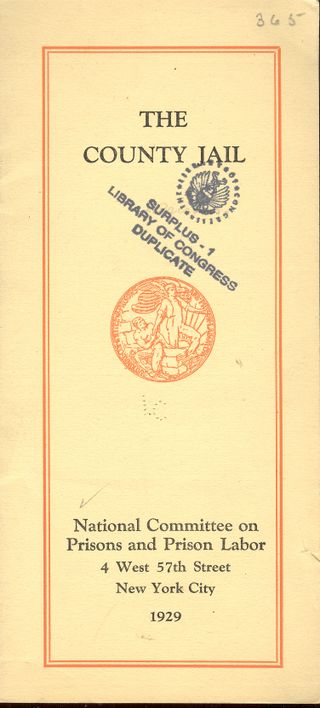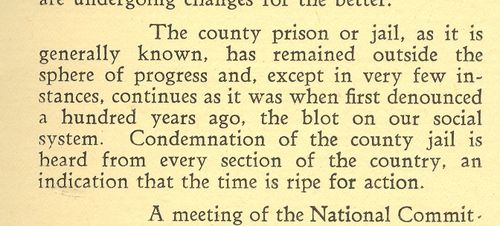JF Ptak Science Books LLC Post 609 Blog Bookstore
This pamphlet is the address by the philanthropist Alfred Lewisohn--a German immigrant who made many dozens of millions of dollars and with his brother became Copper Kings--to the national Committee on Prisons and Prison Labor. Lewisohn was a major contributor and the honorary president of this group--a very liberal, very convincing group with a large measure of outrage with the way in which American crime was addressed and criminals imprisoned.
Lewisohn was enraged with the prison system in the U.S.,though he did have hope for the Federal system, which he hoped would (soon) become the template for the successful treatment of criminals. Everything else below the Federal level was a mess, a mistake, wrong--he thought it absurd that such vast amounts of money would be spent on systems which were milled in deceit, harmful to almost everyone involved, and utterly broken. He saved his greatest vituperative for the county jail, which was beneath contempt.
Lewisohn's complaints, condemnations and suggestions seem, unfortunately, pretty modern--he would also be spinning QUASAR-like in his grave if he had any idea of what was going on now, 80 years after the publication of this paper. Corporal punishment by corrections officers is probably almost entirely gone, replaced by that which is administered by other prisoners; the obscene labor requirements from the prisoners is also pretty much gone, as are other things. The spending, the enormous incarceration rates, the idleness and waste--those are all still there. Except that the incarceration rates--those are far beyond anything that Lewisohn could have imagined. For example, when Lewisohn was writing the incarceration rate that he complained about went from 110,000 people in jail in the U.S in 1920 to 180,000 in 1930. The numbers rose to 272,000 in 1940 , down to 252,000 in 1950, then up again to 332,000 in 1960 and 338,000 in 1970. Things get really bad in the 1980's with the war against drugs: the American prison population rises from 474,000 in 1980 to 1.18 million only ten years later. In 2000, the total rose to 1.9 million, and by 2009 the figure topped 2.4 million. I should also point out that this is a figure for people actually in prison--for those in the criminal justice system, the number balloons to 7.8 million.
And so with the war on drugs, we find ourselves in this country with 1.2 million non-violent people in prison. According to the Justice Policy Institute (and the Bureau of Justice statistics), it costs something like $50 billion to keep these people in jail, or about the cost per year of schooling at an A-school for 1.2 million kids. That figure is also twice the total amount of money spent on the Aid for Families with Dependent Children (AFDC), which services something like 8 million people. With food. The total bill for keeping people in prison in the U.S. is around 100 billion. Its harder for me to calculate the total-total for dealing with the other 5 million somewhere in the criminal justice system--but it is a pretty big figure, coming to some large chunk of a non-wartime military budget. And all that money on something that doesn't work all that well.
[Other social expenditures dwarfed by 50 billion in the continued reading section below...]
Examples of the yearly budgets of other Federal social benefit programs (in US$ billions)
AFDC 24,923Lower income housing asst. 12,307Earned Income Tax Credit 9,553Veterans medical care 7,838Stafford loans 5,683Social Services (Title 20) 5,419Pell Grants 5,374Low-rent public housing 5,008General medical assistance 4,850Foster Care 4,170School Lunch 3,895Pensions for needy veterans 3,667General Assistance 3,340Head Start 2,753Food supplements, Women, infants and children 2,600Training for disadvantaged youth and adults 1,744Low-income energy assistance 1,594Rural housing loans 1,468Indian Health Services 1,431Summer youth employment 1,183Maternal and child health 1,059JOBS and WIN 1,010Job Corps 955Child care block grant 825School Breakfast 782Child care for AFDC 755Nutrition Program for Elderly 659Housing interest reduction 652Child and adult care food program 624"At risk" child care 604




I really appreciate this commentary. I'd like to think that the shocking dollar and resource numbers may wake people up that aren't likely to listen to other types of arguments. Thank you for doing some teasing out of the numbers. It's more than telling.
Posted by: Kathy | 13 May 2009 at 11:36 AM